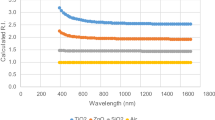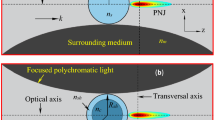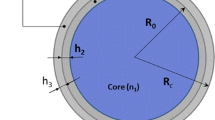Abstract
We present an extensive theoretical study of the optical properties of hollow polymer particles (HPP) dispersed into a polymer resin as functions of their structure and volume-filling fraction. We show that a dependent light scattering model predicts the occurrence of three different light propagation regimes, the existence of which is consistent with experimental data gathered in the literature. We then analyze the effect of the polymer shell thickness on the magnitude of the near-field and far-field dependent light scattering phenomena. We also discuss and compare the variation of the scattering efficiency of Ropaque™, measured in our laboratory, as a function of the pigment volume-filling fraction, with dependent light scattering model. In particular, we show that in the case of HPP, quasi-linear variation of the scattering efficiency as a function of the particle volume-filling fraction is not an undeniable indication of the absence of electromagnetic couplings in the system. Finally, we used a solution of the radiative transfer equation to compare the prediction of the opacity of several simple paint films when a dependent light scattering model is used instead of the independent scattering approximation to calculate the optical properties of the films at a local scale.






















Similar content being viewed by others
References
Ross, W, “Theoretical Computation of Light Scattering Power: Comparison Between TiO2 and Air Bubbles.” J. Paint Technol., 43 (563) 50–65 (1971)
Kerker, M, Cooke, D, Ross, W, “Pigmented Microvoid Coatings: Theoretical Study of Three Models.” Paint Res. Inst., 47 (603) 33–41 (1975)
Diebold, MP, “A Monte Carlo Determination of the Effectiveness of Nanoparticles as Spacers for Optimizing TiO2 Opacity.” J. Coat. Technol. Res., 8 (5) 541–552 (2011)
Foldy, LL, “The Multiple Scattering of Waves.” Phys. Rev., 67 107–119 (1945)
Lax, M, “Multiple Scattering of Waves.” Rev. Modern. Phys., 23 287–310 (1951)
Mukherjee, Suprokash, “Scattered Wave and Lippmann-Schwinger Equation.” Phys. Lett. A, 83 (1) 1–8 (1981)
Luebbers, R, Hunsberger, F, Kunz, K, Standler, R, Schneider, M, “A Frequency-Dependent Finite-Difference Time-Domain Formulation for Dispersive Materials.” IEEE Trans. Electromagn. Compat., 32 (3) 222–227 (1990)
Mackowski, DW, “Analysis of Radiative Scattering for Multiple Sphere Configurations.” Proc. R. Soc. London, Ser. A, 433 599–614 (1991)
Auger, JC, Stout, B, “A Recursive Centered T-Matrix Algorithm to Solve the Multiple Scattering Equation: Numerical Validation.” J. Quant. Spectrosc. Radiat. Transfer, 79 (80) 533–547 (2003)
Auger, JC, Stout, B, Martinez, V, “Absorption and Scattering Properties of Dense Ensemble of Nonspherical Particles.” J. Opt. Soc. Am. A, 24 (11) 3508–3516 (2007)
Mishchenko, MI, Liu, L, Hovenier, JW, “Effects of Absorption on Multiple Scattering by Random Particulate Media: Exact Results.” Opt. Express, 15 (20) 2822–2836 (2007)
Auger, JC, Martinez, VA, Stout, B, “Theoretical Study of the Scattering Efficiency of Rutile Titanium Dioxide Pigments as a Function of Their Spatial Dispersion.” J. Coat. Technol. Res., 6 (1) 89–97 (2009)
Loiko, VA, Dick, VP, Molochko, VI, “Monolayers of Discrete Scatterers: Comparison of the Single-Scattering and Quasi-Crystalline Approximations.” J. Opt. Soc. Am., 15 (9) 2351–2354 (1998)
Ma, Y, Varadan, VV, Varadan, VK, “Scattered Intensity of a Wave Propagating in a Discrete Random Medium.” Appl. Opt., 27 (12) 2469–2477 (1988)
Tsang, L, Pan, J, Liang, D, Li, Z, Cline, DW, Tan, Y, “Modeling Active Microwave Remote Sensing of Snow Using Dense Media Radiative Transfer (DMRT) Theory with Multiple-Scattering Effects.” IEEE Trans. Geosci. Remote Sens. 45 (4) 990–1004 (2007)
Dick, VP, Ivanov, AP, “Extinction of Light in Dispersive Media with High Particle Concentrations: Applicability Limits of the Interference Approximation.” J. Opt. Soc. Am. A, 16 (5) 1034–1039 (1999)
Auger, JC, Stout, B, “Dependent Light Scattering in White Paint Films: Clarification and Application of the Theoretical Concepts.” J. Coat. Technol. Res., 9 (3) 287–295 (2012)
Henderson, D, “Analytic Methods for the Percus-Yevick Hard Sphere Correlation Function.” Condens. Matter Phys., 12 (2) 127–135 (2009)
Park, JM, “Preparation of Hollow Polymer Particles as Model Colloids.” J. Ind. Chem., 7 (1) 23–29 (2001)
Park, JM, “Light Scattering by Models Microvoid Films.” J. Ind. Chem., 7 (1) 11–22 (2001)
Auger, J-C, Stout, B, “Discussion on Dependent Light Scattering Phenomenon in White Paint Films.” J. Coat. Technol. Res., (2013). doi:10.1007/s11998-013-9539-6
Ross, WD, “Theoretical Computation of Light Scattering Power: Comparison Between TiO2 and Air Bubbles.” J. Paint Technol., 45 (563) 50–66 (1971)
Tsang, L, Kong, JA, Shin, RT, Theory of Microwave Remote Sensing. Wiley Interscience, New York (1985)
Ishimaru, A, Kuga, Y, “Attenuation Constant of a Coherent Field in a Dense Distribution of Particles.” J. Opt. Soc. Am., 72 (10) 1317–1320 (1982)
Hespel, L, Mainguy, S, Greffet, J-J, “Theoretical and Experimental Investigation of the Extinction in a Dense Distribution of Particles: Nonlocal Effects.” J. Opt. Soc. Am. A, 18 (12) 3072–3076 (2001)
Auger, J-C, Sout, B, Martinez, V, “Scattering Efficiency of Aggregated Clusters of Spheres: Dependence on Configuration and Composition.” J. Opt. Soc. Am. A, 22 2700–2708 (2005)
Chandrasekhar, S, Radiative Transfer. Dover Publications Inc, New York (1960)
Auger, JC, Stout, B, Lafait, J, “Dependent Light Scattering in Dense Heterogeneous Media.” Physica B., 279 21–24 (2000)
Mudgett, PS, Richard, LW, “Multiple Scattering Calculation for Technology.” Appl. Opt., 107 1485–1502 (1971)
Malacara, D, Color Vision and Colorimetry. SPIE Press, Washington (2002)
Burresi, M, Cortese, L, Pattelli, L, Kolle, M, Vukusic, P, Wiersma, DS, Steiner, U, Virgnoli, S, “Bright-White Beetle Scales Optimise Multiple Scattering of Light.” Sci. Rep., (2014). doi:10.1038/srep06075
Garcia, N, Genack, AA, Lisyansky, AA, “Measurement of the Transport Free Path of Diffusing Photons.” Phys. Rev. B, 46 (22) 475–479 (1992)
Acknowledgments
The authors would like to acknowledge the AkzoNobel Decorative Paint Business area and Simon Davies from AkzoNobel Expert Capability Group for supporting this work. We also greatly thank Fraser Robertson and Bogdan Ibanescu of AkzoNobel Decorative Research Group for realizing the experimental work on Ropaque Ultra. The authors would also like to thank the anonymous reviewers for their valuable comments and suggestions to improve the content of this manuscript.
Author information
Authors and Affiliations
Corresponding author
Appendix
Appendix
Appendix A: Optical parameters
The scattering coefficient denoted as s is defined as the product of the number of particles by unit volume, noted as ρ 0, with the scattering cross section C sca.
The scattering efficiency noted as S, also called reduced scattering coefficient in transport theory, is given by the product of the scattering coefficient and the term (1 − g), where g represents the asymmetry parameter.
The asymmetry parameter represents the average cosine of the scattering angle. It characterizes the asymmetry of the phase function p(θ,ϕ) and it ranges from −1 to 1.
When g is close to zero, the scattering process is mainly isotropic. When g tends to 1, the phase function is strongly anisotropic with a strong maximum in the forward direction near θ = 1 angle. A negative value of g indicates that more light is scattered in the backward hemisphere than in the forward hemisphere.
In the diffusion theory of light, the scattering efficiency is related to the inverse of the transport mean free path.32 The latter is defined as the length scale on which the direction of propagation is randomized, i.e., when the scattered direction is totally de-correlated from the initial incident direction.
Appendix B: Correlation function
The correlation function denoted as Γ is defined as the ratio between the values of the optical parameters calculated via the dependent and independent light scattering frameworks, respectively. Thereby
where s IND and S IND represent the scattering coefficient and scattering efficiency calculated via the independent light scattering assumption. The expression Γ(ϕ) refers to either Γ S(ϕ) or Γ C(ϕ). The correlation function provides information on the strength of the dependent light scattering phenomenon in the overall light scattering process. The greater the value of Γ(ϕ) is different from unity, the stronger are the dependent light scattering effects.
In,26 the notion of radius of transition was introduced to characterize the dimension at which the correlation function of a given system transits from Γ(ϕ) < 1 to Γ(ϕ) > 1. It was assumed that the radius of transition was a function of the indices of refraction of the scattering particles and the medium of propagation.
Rights and permissions
About this article
Cite this article
Auger, JC., McLoughlin, D. Theoretical study and experimental analysis of the scattering efficiency of hollow polymer particles in the dependent light scattering regime. J Coat Technol Res 12, 693–709 (2015). https://doi.org/10.1007/s11998-015-9677-0
Published:
Issue Date:
DOI: https://doi.org/10.1007/s11998-015-9677-0




